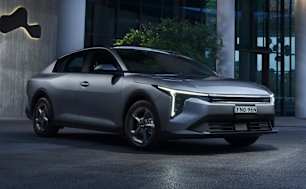Starting up the Skoda Superb Sportline you hear the familiar sound of this 2.0L engine, variations of which are used in numerous VW Group models. It’s fairly muted and smooth, which makes the cabin a serene place to be.
Setting off you use the column-mounted gear selector to change gears. It takes a little bit to get used to the new placement, but after a few uses it feels normal. This relocation has also allowed for so much more storage on the centre console.
Around town the Superb’s 2.0-litre turbocharged four-cylinder petrol engine barely makes itself known. The full 400Nm of torque comes on tap from as little as 1650rpm, making this car effortless to drive and almost turbo-diesel-like in practice.
Skoda claims the new Superb can do the 0-100km/h sprint in 5.6 seconds in liftback guise and 5.7 seconds in wagon guise. This is 0.3 seconds faster than the old version.
It barely requires any thought driving in the typical urban sprawl. The car does all the heavy lifting for you.
When it comes to parking, however, there’s no way around the fact this is a long car. You may find yourself needing to do three-point turns in order to navigate tighter urban car parks.
It doesn’t help that the surround-view camera system is surprisingly low-resolution, which is disappointing given the Superb is a flagship vehicle for Skoda. It’s more noticeable because the central touchscreen is incredibly high-resolution.
As standard there’s a seven-speed dual-clutch automatic transmission which has one more ratio than the previous-generation Superb. Though this isn’t necessarily obvious in everyday driving, the dual-clutch is still a classic Volkswagen Group unit, meaning it’s snappy and intuitive.
This car comes with a progressive ratio steering system which increases the amount the wheels physically turn as you feed on more lock with the steering wheel. It helps make the car feel more agile and sporty, while also requiring less effort.
With the updated adaptive dampers you can now configure the system in 15 different ways, which is wild. This spans all the way from beyond ‘Comfort’ through to ‘Sport’.
In ‘Normal’ mode the Superb still errs on the sportier side, which makes sense because the Sportline package is standard. This also brings a 15mm ride height reduction.
Despite feeling sporty as standard, the Superb is never uncomfortable. This is really surprising because there are sizeable 19-inch alloy wheels and low-profile tyres.
Dialling the car through to ‘Comfort’ mode makes the drive pretty much effortless. It’s incredibly comfortable and supple, ironing out virtually any road imperfection you can throw at it.
Unlike other Skoda vehicles with adaptive dampers, this Superb doesn’t get that bouncy cloud-like feeling in ‘Comfort’ mode. Instead, it still feels grounded.
There’s an ‘Eco’ drive mode which unsurprisingly prioritises fuel economy. It makes upshifts happen low down in the rev range, and also shifts the car into neutral when coasting.
Although the car is in ‘Eco’ mode, it doesn’t feel like you’re lacking any oomph. You’ll still be keeping up with urban traffic easily.
Slotting the Superb into ‘Sport’ mode immediately sharpens the throttle response and makes the car feel like it’s hunkering down, ready to attack. The suspension and adaptive dampers noticeably become stiffer, making you jiggle about in the driver’s seat more than in other drive modes.
It’s surprising how Sport makes this huge sedan and wagon feel much smaller than it is. This is likely credit to how dynamic the Volkswagen Group has made its 'MQB Evo' platform.
Thanks in part to the all-wheel drive system, this car is an absolute beast out in the twisties. You can take corners with a lot of heat and still feel incredibly in control.
Once again, the car does a lot of the heavy lifting, allowing you to focus on what’s going on with the road ahead. It’s very smile-inducing.
While this car is dynamic and thrilling to drive, it’s worth noting it’s no full-fat RS model. You reach a ceiling with the turbo-petrol’s outputs when accelerating hard, but there’s still plenty to play with. Only proper performance car nerds will care about this.
Out on the open road, the Superb becomes a great long-distance tourer. It feels like I could drive from Melbourne to Adelaide in one hit without stopping.
At higher speeds, however, there is a bit of road and tyre noise. This is common in European vehicles, but still ruins the ambience of the cabin if you don’t like listening to music behind the wheel.
More concerning, though, is the virtually brand-new Superbs we sampled at this media launch were already starting to develop noticeable rattles in the door cards. Underwhelming in a circa $70K car.




























.png)
















_1.png)
.png)


